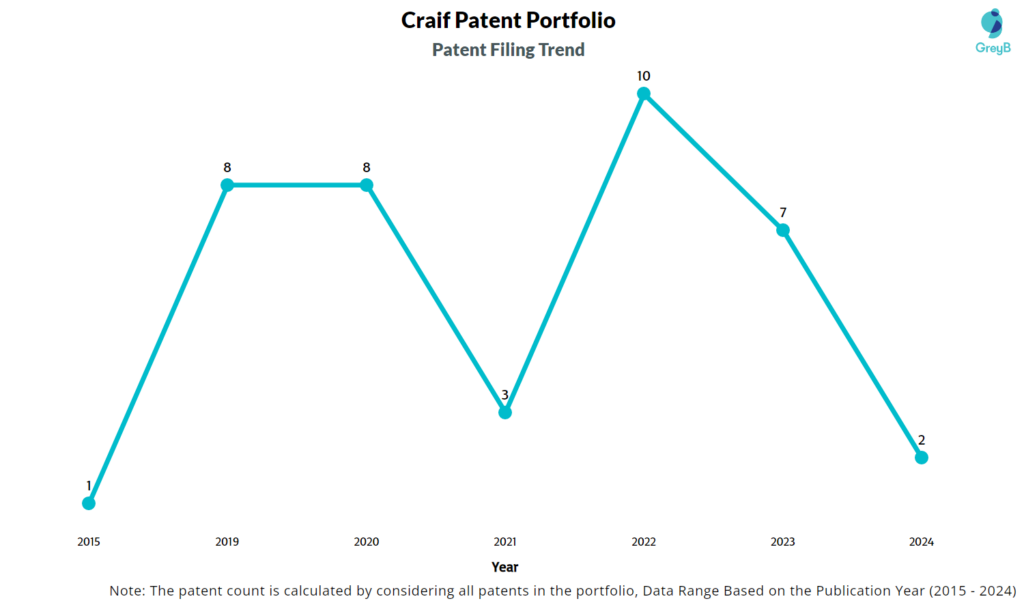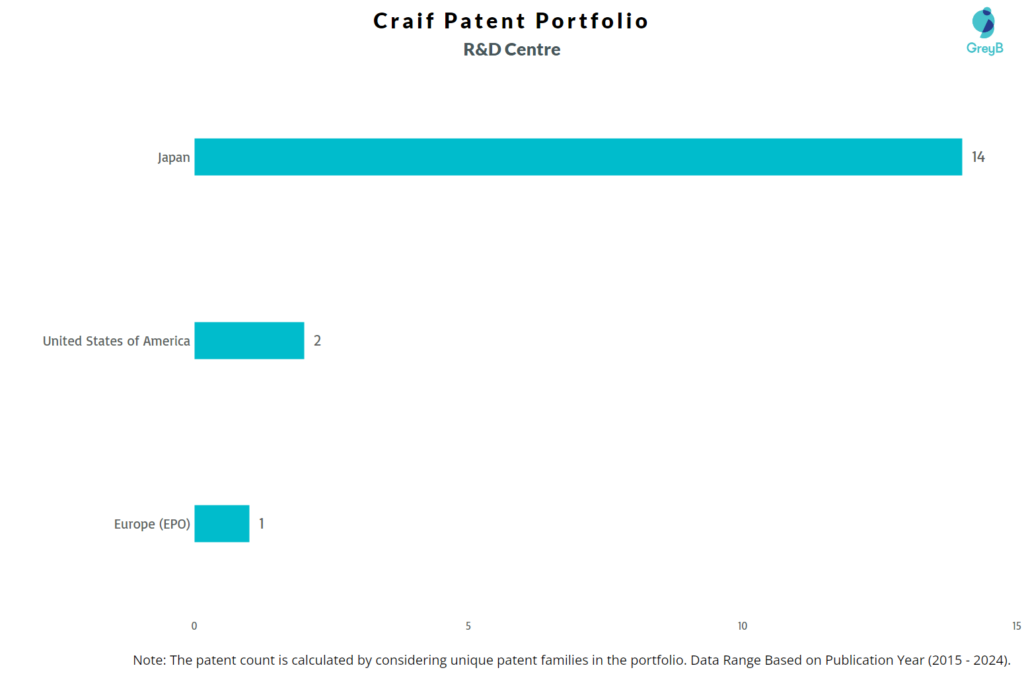Craif has a total of 39 patents globally, out of which 7 have been granted. Of these 39 patents, more than 79% patents are active. The United States of America is where Craif has filed the maximum number of patents, followed by Japan and Europe (EPO). Parallelly, Japan seems to be the main focused R&D centre and also is the origin country of Craif.
Craif was founded in 2018. The company offers exosome-based liquid biopsy tests for accurate, painless early cancer detection. Their bio-platform captures RNA, including non-coding RNA that affects gene expression and links closely to disease status. This technology allows research institutions to distinguish cancer from non-cancer samples with high sensitivity and accuracy across two cancer types.
Do read about some of the most popular patents of Craif which have been covered by us in this article and also you can find Craif patents information, the worldwide patent filing activity and its patent filing trend over the years, and many other stats over Craif patent portfolio.
How many patents does Craif have?
Craif has a total of 39 patents globally. These patents belong to 17 unique patent families. Out of 39 patents, 31 patents are active.
How Many Patents did Craif File Every Year?

Are you wondering why there is a drop in patent filing for the last two years? It is because a patent application can take up to 18 months to get published. Certainly, it doesn’t suggest a decrease in the patent filing.
| Year of Patents Filing or Grant | Craif Applications Filed | Craif Patents Granted |
| 2024 | 2 | 3 |
| 2023 | 7 | 3 |
| 2022 | 10 | – |
| 2021 | 3 | – |
| 2020 | 8 | – |
| 2019 | 8 | 1 |
| 2015 | 1 | – |
How many Craif patents are Alive/Dead?
Worldwide Patents

How Many Patents did Craif File in Different Countries?

Countries in which Craif Filed Patents
| Country | Patents |
| United States of America | 12 |
| Japan | 8 |
| Europe (EPO) | 8 |
Where are Research Centers of Craif Patents Located?

List of Craif patents
| Publication Number | Title |
| US12038360B2 | Device To Be Used For Capturing Extracellular Vesicles, And Preservation Method And Transport Method For Extracellular Vesicles |
| JP7503841B2 | Mirna Extraction Method And Mirna Analysis Method |
| JP7426725B2 | Devices Used To Capture Extracellular Vesicles, Methods For Storing And Transporting Extracellular Vesicles |
| US20240363248A1 | Neural-Network-Based Classifier |
| US20240352532A1 | Methods For Categorizing Disease Outcomes |
| US20240110248A1 | Extract From A Body Fluid Comprising A Micro Rna |
| US20240068034A1 | Mirnas, Compositions, And Methods Of Using Thereof |
| EP4230745A4 | Method For Evaluating Likelihood Of Observation Value And Program |
| EP4392988A1 | Neural-Network-Based Classifier |
| EP4386484A1 | Method For Patterning Substrate, Method For Forming Microstructure On Substrate, And Method For Fabricating Fluidic Device |
| EP4029940A4 | Body Fluid Extract Containing Micro Rna |
| EP4036233A4 | Method For Detecting Brain Tumor |
| EP4314321A1 | Mirnas, Compositions, And Methods Of Using Thereof |
| WO2024085247A1 | Method For Fusing Lipid Nanoparticles |
| WO2024085079A1 | Primer Set, Kit For Determining Onset And/Or Onset Risk Of Spinal Muscular Atrophy, And Method For Determining Onset And/Or Onset Risk Of Spinal Muscular Atrophy |
| WO2024063121A1 | Method For Forming Microdroplets |
| JP2024532874A | Neural Network Based Classifier |
| JP2024088754A | Biomolecule Recovery Device And Method As Well As Biomolecule Analysis Device And Method |
| JP2024516504A | Mirna, Compositions And Methods Of Use Thereof |
| US11845975B2 | Extract From A Body Fluid Comprising A Micro Rna |
| US11571695B2 | Fluidic Device And Method For Separating Biomolecules |
| JP7394441B2 | How To Test For Brain Tumors |
| US20230359707A1 | Method For Evaluating Likelihood Of Observation Value And Program |
| US20230265521A1 | Body Fluid Extract Containing Micro Rna |
| WO2023219095A1 | Method For Separating Target Substance Contained In Target Liquid |
| WO2023171012A1 | Methods For Categorizing Disease Outcomes |
| WO2023026996A1 | Neural-Network-Based Classifier |
| WO2023017801A1 | Method For Patterning Substrate, Method For Forming Microstructure On Substrate, And Method For Fabricating Fluidic Device |
| JP2023123592A | Body Fluid Extract Containing Micro Rna |
| US20220349888A1 | Method For Detecting Brain Tumor |
| US20220143613A1 | Biomolecule Recovering Device And Method, And Biomolecule Analyzing Device And Method |
| US20220033803A1 | Method Of Extracting Mirna And Method Of Analyzing Mirna |
| EP3919917A4 | Biomolecule Recovering Device And Method, And Biomolecule Analyzing Device And Method |
| EP3875570A4 | Device To Be Used For Capturing Extracellular Vesicles, And Preservation Method And Transport Method For Extracellular Vesicles |
| WO2022202854A1 | Mirnas, Compositions, And Methods Of Using Thereof |
| WO2022080389A1 | Method For Evaluating Likelihood Of Observation Value And Program |
| WO2021060311A1 | Method For Detecting Brain Tumor |
| WO2021049671A1 | Body Fluid Extract Containing Micro Rna |
| JP6606786B2 | Biomolecule Extraction Chip And Method For Manufacturing Biomolecule Extraction Chip |
What are Craif key innovation segments?
What Technologies are Covered by Craif?

The chart below distributes patents filed by Craif in different countries on the basis of the technology protected in patents. It also represents the markets where Craif thinks it’s important to protect particular technology inventions.

R&D Focus: How has Craif search focus changed over the years?

EXCLUSIVE INSIGHTS COMING SOON!
Interested in knowing about the areas of innovation that are being protected by Craif?

